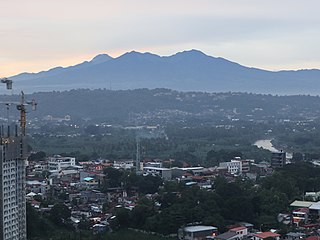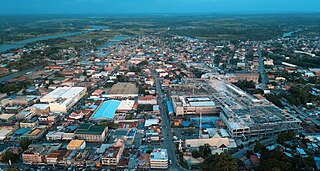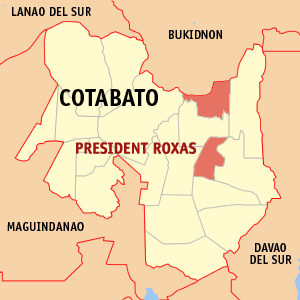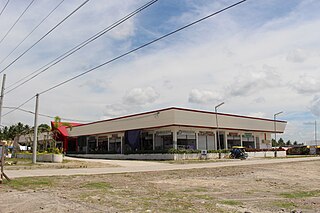Establishment and territorial changes
Kidapawan has roots in the municipal district with the same name which was created in 1914 by the Americans, and consisted the territory of the Monuvu. Datu Siawan Ingkal, a tribal leader, was appointed District President. Later, Ilonggo settlers increased in the area. [7]
Through Executive Order No. 82 signed by President Manuel Roxas on August 18, 1947, which organized almost all municipal districts of Cotabato into ten municipalities, Kidapawan was among those converted, [8] merging with it the unexplored region in the north, [8] as well as the then-forested M'lang-Tulunan area, a Maguindanaon territory in the southeast border. [7] The territory extended to the borders of the provinces of Bukidnon and then-undivided Davao through Matanao River, [9] to the north and the east, respectively; Kabacan to the west, meeting with Pulangi River; [7] [8] and M'lang area, then part of Buluan, [8] and the Ligawasan Marsh, [7] to the south. [9]
As a result, the size was more than thrice the present. The vast area in its extent was once described in the 1950s being larger than the province of Cavite. The original territory, now called the Greater Kidapawan Area [9] and currently includes the city itself and eight—five daughter and three granddaughter—municipalities (including part of Matalam), occupies more than half of the present-day Cotabato, [7] in the northern and eastern part. [9] It also composed the portion of Bansalan east of the Matanao River.
It was partitioned gradually over the next two decades with the establishment of separate municipalities: [7]
- M'lang (1951) in the south, which included the present-day territory of Tulunan.
- Makilala (1954) and Magpet (1963) in the east; the latter is Kidapawan's largest single loss of territory to date, included the present-day territory of Arakan.
- Matalam (1961) in the west, with taken territory merged with that from M'lang and Kabacan; included the present-day territory of Antipas.
- President Roxas (1967) in the north.
With the partitions, the municipality lost all its original borders, although it shares Mount Apo with Davao and four other towns. [7]
The partitioning was almost opposed, mainly because of the possibility of becoming a city. The municipal council petitioned to change the border of Makilala, and even urged President Diosdado Macapagal to cancel the establishment of Matalam; but both were unsuccessful. [7]
Events from the pre-colonial era until pre-cityhood
Kidapawan has its roots in pre-colonial settlements of the Obo Monuvu, the indigenous peoples that have lived at the foot of Mount Apo on both the Cotabato and Davao sides for generations. The Monuvu, along with other tribes in the area with whom they frequently intermarried, remained independent throughout the Spanish colonial period, as the Spaniards were never able to surmount Mount Apo on the Davao side nor penetrate beyond the Ligawasan Marsh on the Cotabato side. The chieftains of the tribes in the Greater Kidapawan Area remained independent but maintained relations with the nearby Maguindanaon sultanates, the closest of which were the Sultanate of Buayan in Dulawan (today Datu Piang, Maguindanao), and its related settlement, the Sultanate of Bagua Inged in what is today Pikit and Pagalungan. The Monuvu settlements, the precursors of many of Kidapawan's modern day Baranggays, existed autonomously with one another but were ruled by chieftains often related by centuries of intermarriage.
Some time before the coming of the Americans, the different tribal settlements west of the Matanao river apparently fell under the influence of a Datu Ingkal (in some sources he is named Datu Ingkal Ugok), who became paramount chieftain over the different settlements within the Kidapawan area. When the Americans came they recognized Datu Ingkal's leadership, and records say he was appointed ‘Capitan’ by a Col. Stevens in 1908, presumably as head of a tribal ward under what was then the Cotabato District of the Moro Province [10]
When Datu Ampatuan of Maganoy threatened to stage a rebellion against the Americans in 1913, Datu Ingkal is recorded as threatening to side with him. The Americans sought to pacify the two datus by offering appointments and administrative arrangements. [11] [12]
Datu Ingkal's territory, Kidapawan, would be formed into a Municipal District on July 23, 1914, one of twenty seven under the newly created Cotabato Province of the Department of Mindanao and Sulu as mandated under Article 19 of Act No. 2408. [13] Datu Siawan Ingkal, son of Datu Ingkal Ugok, would be appointed Municipal District President. The act was made official with Act No. 2711 approved on March 10, 1917, mentioning Kidapawan as a municipal district. [14] The Cornejo Commonwealth Directory of 1939, published under the newly elected Quezon government, still names Datu Siawan as District President, with Datu Amag Madut as vice president.
Kidapawan's establishment as a Municipal District paved the way for settlers from Luzon and Visayas to come over the succeeding decades up until the 1960s. Kidapawan was not a planned colony, but it was surrounded by planned colonies on both sides, thus encouraging individual migration: Davao, a Spanish colony in the late 1800s, Pikit, an agricultural colony set up by the Americans, the settlements of the National Land Settlement Administration (NLSA) in what is today South Cotabato, and much later the colony of Alamada under Magsaysay's National Resettlement and Rehabilitation Administration (NARRA). The diverse ethnic composition of Kidapawan's settler population, with Cebuanos, Tagalogs, Ilonggos, Chinese, and Igorots, reflect both the gradual individual efforts of migrants and Kidapawan's position as the transition area between Cebuano-dominated Davao and Ilonggo-dominated Cotabato.
There are conflicting accounts as to where the original center of Kidapawan was before the War. Tribal and settler sources name either Manongol (for a time called ‘Old Kidapawan’) or Lanao as centers, with some sources identifying Lanao as the commercial center of the town where the settlers concentrated, with Manongol the seat of Siawan Ingkal's chieftaincy.
The details of Kidapawan's arrangements during the Second World War are unclear, but it seems to have been one of the Municipal Districts elevated in 1942 to Municipality by virtue of Executive Order No. 43 of the Japanese-sponsored Executive Commission.
No records attest to it, but informants (primary among them Rosita Blanco Cadungog) names Filomeno Blanco as the local appointed Mayor by the Japanese during their occupation of Kidapawan. There are even less details on the arrangements of the resistance government, but Kidapawan fell under the command of Datu Udtog Matalam, who with his Bolo Battalion led the Cotabato region's guerrilla movement. Records indicate that in 1942 Alfonso O. Angeles Sr. had been appointed ‘Mayor of the Upper Cotabato Sector,’ to which Kidapawan presumably belonged, while the Paclibar family describes a ‘Civil Emergency Administration’ in M’lang under the 118th Infantry Regiment of the 106th Division of Wendell Fertig's 10th Military District (the resistance detachment in Mindanao during the War), headed by Jacinto Paclibar. [9]
When the War ended, Kidapawan's administrative status was in limbo, but in all likelihood it was reverted to Municipal District. No documents also confirm it, but informants like Erlinda Villanueva Asuelo name Ceferino J. Villanueva as acting mayor after the War up to the election of 1947.
The election of 1947 resulted in the victory of Alfonso O. Angeles Sr. The first elected Vice Mayor was Datu Siawan Ingkal, while the first elected Councilors were Gil dela Cruz, Lorenzo A. Saniel, Lino Madrid, Ricardo Ipong, Norberto Cajucom, and Arsenio Sibug. The first Municipal Government began functioning in 1948.
When the second partitioning of the Empire Province of Cotabato happened in the 1970s, Kidapawan became the provincial capital of the much-reduced Cotabato Province (now colloquially called North Cotabato) by virtue of Presidential Decree No. 341, issued by Ferdinand Marcos on November 22, 1973.






























